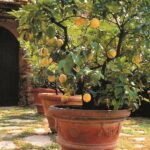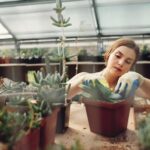Are you looking for creative container gardening ideas for vegetables? Whether you have limited outdoor space or simply want to bring your garden closer to home, container gardening is a great way to grow fresh vegetables right on your doorstep. In this article, we will explore the exciting world of container gardening and provide you with tips, tricks, and ideas for successfully growing vegetables in containers.
Container gardening offers a convenient and flexible way to cultivate a variety of vegetables, herbs, and fruits in a limited space. From small balconies to sunny windowsills, there are endless possibilities for creating a bountiful garden using containers.
In this section, we will introduce the concept of container gardening for vegetables and discuss its many benefits, from improved accessibility to greater control over soil quality and watering. Whether you’re a beginner or experienced gardener, there’s always something new to learn when it comes to container gardening ideas for vegetables.
We will also delve into the key factors to consider when selecting the right containers for growing vegetables. From size and material to drainage and mobility, choosing the appropriate containers is essential for creating a thriving garden.
Additionally, we will provide valuable insights into selecting the best vegetables for container gardening and offer essential tips on maintaining and caring for your vegetable plants. So get ready to unleash your green thumb as we embark on an exciting journey into the world of container gardening ideas for vegetables.
Selecting the Right Containers for Growing Vegetables
When it comes to container gardening ideas for vegetables, selecting the right containers is crucial for the success of your garden. The size, material, and drainage of the container all play a significant role in how well your vegetables will grow.
Size Matters
The size of your container will depend on the type of vegetable you plan to grow. Larger vegetables such as tomatoes, peppers, and eggplants will require larger containers to accommodate their root systems. On the other hand, smaller vegetables like lettuce, spinach, and herbs can thrive in smaller pots or even hanging baskets. It’s important to research the specific space requirements for each vegetable you plan to grow and choose your containers accordingly.
Materials
Containers can be made from various materials such as plastic, terracotta, wood, or fabric. Each material has its advantages and disadvantages when it comes to growing vegetables. Plastic containers are lightweight and affordable but may not provide adequate insulation for plant roots. Terracotta pots are attractive and provide good airflow but can dry out quickly.
Wood containers are durable but may rot over time. Fabric pots are lightweight, breathable, and provide excellent drainage. Consider the pros and cons of each material before making your selection.
Drainage
Proper drainage is essential for container gardening success. Without adequate drainage holes in your containers, water can collect at the bottom and cause root rot or other diseases in your plants. When choosing containers for growing vegetables, be sure to select ones that have sufficient drainage holes or modify them yourself if necessary.
By carefully considering the size, material, and drainage of your containers for growing vegetables, you can set yourself up for a successful container garden full of thriving produce.
Choosing the Best Vegetables for Container Gardening
When it comes to choosing the best vegetables for container gardening, there are a variety of options that are well-suited for this growing method. Here are some popular vegetables that thrive in containers:
1. Tomatoes: Tomatoes are one of the most popular choices for container gardening. They require a large pot and plenty of sunlight, but with the right care, you can enjoy a bountiful harvest of fresh, juicy tomatoes.
2. Peppers: Peppers, such as bell peppers and chili peppers, also do well in containers. They need ample sunlight and regular watering to produce flavorful and colorful peppers.
3. Lettuce and Salad Greens: For those who enjoy fresh salads, lettuce and other salad greens like spinach and arugula can be easily grown in containers. These leafy greens thrive in cooler temperatures and partial shade.
4. Carrots: Carrots can be grown in deep containers filled with loose soil to accommodate their long taproots. With consistent watering and thinning when necessary, you can harvest crunchy and sweet homegrown carrots.
5. Herbs: Herbs like basil, parsley, mint, and cilantro are ideal for container gardening due to their compact size and fast growth. They can be grown on a sunny windowsill or on a balcony in small pots.
By choosing the right vegetables for your container garden, you can enjoy a plentiful harvest of fresh produce right at your fingertips. Whether you have limited outdoor space or simply want to add greenery to your patio or balcony, these container gardening ideas vegetables will allow you to enjoy the satisfaction of growing your own food.
Essential Gardening Tools and Supplies for Container Gardening
When it comes to container gardening for vegetables, having the right tools and supplies can make all the difference in the success of your garden. Here are some essential items you’ll need to get started with your vegetable container garden:
Containers
The first and most obvious item you’ll need for container gardening is, of course, the containers themselves. When selecting containers for growing vegetables, be sure to choose ones that are large enough to accommodate the root systems of your chosen plants. You’ll also want to consider factors such as material (plastic, ceramic, clay, etc.), drainage holes, and mobility (if you plan on moving your containers around).
Soil
Good quality soil is essential for healthy plant growth in any type of gardening, and container gardening is no exception. Look for a high-quality potting mix that is specially formulated for container gardening. Avoid using soil from your yard, as it may not provide the necessary nutrients and drainage for potted plants.
Watering Can or Hose
Proper watering is crucial for container gardening success, so invest in a good quality watering can or hose with a gentle spray attachment. This will allow you to water your plants without disturbing their delicate root systems.
Fertilizer
Because the nutrients in potting soil can become depleted over time, it’s important to regularly feed your container-grown vegetables with a balanced fertilizer. Look for a fertilizer specifically designed for vegetables and follow the instructions on the label for best results.
By ensuring you have these essential tools and supplies on hand, you’ll be well-equipped to start your own successful container garden full of delicious homegrown vegetables.
Tips for Successful Container Gardening of Vegetables
Container gardening is a great way to grow vegetables even if you don’t have space for a traditional garden. Here are some tips for successful container gardening of vegetables:
1. Choose the right container: Make sure your containers have adequate drainage and are large enough for the vegetable plants you want to grow. Consider using options like plastic pots, wooden crates, or even repurposed items like buckets and barrels.
2. Use high-quality soil: Select a potting mix specifically designed for container gardening, as it will provide the proper nutrients and drainage that your vegetables need to thrive.
3. Provide adequate sunlight: Most vegetable plants require at least 6 hours of sunlight per day, so be sure to place your containers in a sunny spot on your patio or balcony.
4. Proper watering: Container gardens can dry out quickly, so it’s important to check the moisture level of the soil regularly and water as needed. Consider investing in a drip irrigation system or self-watering containers to make this task easier.
5. Regular fertilizing: Since container-grown vegetables may deplete nutrients from the soil more quickly than those grown in the ground, it’s important to regularly fertilize your plants with a balanced fertilizer designed for vegetables.
By following these tips, you can enjoy a bountiful harvest of fresh, homegrown vegetables from your container garden throughout the growing season. Whether you’re growing tomatoes on your apartment balcony or cultivating peppers on your patio, container gardening offers endless possibilities for growing delicious and nutritious produce right outside your door.
Creative and Unique Container Ideas for Growing Vegetables
When it comes to container gardening ideas for vegetables, there are a variety of creative and unique options that can be both functional and visually appealing. One popular idea is using repurposed items as containers, such as old tires, buckets, or even wooden crates. These not only add an interesting element to your garden but also help reduce waste by giving new life to old items.
Another creative container idea is vertical gardening, which involves using hanging containers or vertical planters to maximize space and create a stunning visual display. This is especially useful for those with limited space, as it allows you to grow a variety of vegetables in a small area, making the most out of your available space.
If you’re looking for a more artistic approach to container gardening, consider using colorful and decorative pots to add a pop of visual interest to your vegetable garden. Whether it’s bright ceramic pots or intricately designed planters, choosing containers that complement your outdoor space can elevate the overall look of your garden while still providing a suitable environment for your vegetables to thrive.
| Container Gardening Idea | Description |
|---|---|
| Repurposed Items | Use old tires, buckets, or wooden crates as unique containers. |
| Vertical Gardening | Utilize hanging containers or vertical planters for maximum space efficiency. |
| Artistic Pots | Incorporate colorful and decorative pots for an aesthetic appeal. |
Maintaining and Caring for Vegetables in Containers
Once you have successfully planted your vegetables in containers, it is essential to focus on their maintenance and care to ensure they thrive and produce a bountiful harvest. One critical aspect of maintaining container-grown vegetables is regular watering.
Since the soil in containers tends to dry out faster than garden soil, it’s important to monitor the moisture levels and water as needed. Additionally, using a high-quality organic fertilizer specifically designed for container gardening can help provide the necessary nutrients for your vegetables to grow.
In addition to watering and fertilizing, caring for vegetables in containers also involves monitoring for pests and diseases. Regularly inspect your plants for any signs of pest damage or disease, such as holes in leaves or discoloration. Applying natural pest control methods like neem oil or introducing beneficial insects can help keep these issues at bay. Furthermore, practicing good container garden hygiene by regularly removing dead or diseased plant material can also prevent the spread of diseases.
Another aspect of caring for vegetables in containers is providing adequate support for vining or tall-growing plants. Using trellises, stakes, or cages can help prevent sprawling and support the growth of plants like tomatoes, cucumbers, or peas. Proper pruning can also help maintain the overall health and productivity of your container-grown vegetables.
| Tip | Description |
|---|---|
| Regular Watering | Monitor moisture levels and water as needed to combat faster drying out of soil. |
| Pest Control | Inspect plants regularly for signs of pest damage and disease; apply natural pest control methods if necessary. |
| Support Systems | Use trellises, stakes, or cages to provide support for vining or tall-growing plants; practice proper pruning. |
Harvesting and Enjoying the Fruits of Your Container Gardening Efforts
Harvesting your own vegetables from your container garden is an incredibly rewarding experience. Not only do you get to enjoy the satisfaction of growing your own food, but you also get to savor the fresh, delicious flavors of home-grown produce.
When it comes to harvesting your vegetables, timing is key. Each type of vegetable has its own ideal harvest time, so it’s important to keep an eye on your plants and harvest them at the right moment for the best flavor and texture.
One of the benefits of container gardening is that it allows you to control the environment in which your vegetables grow. This means you can extend your growing season and enjoy fresh produce for a longer period of time.
For example, if you’re growing tomatoes in containers, you can bring them indoors when temperatures start to drop, allowing you to continue harvesting tomatoes well into the fall. This flexibility is one of the many advantages of container gardening and can enhance your overall gardening experience.
After harvesting your vegetables, it’s time to enjoy the fruits of your labor. There’s nothing quite like making a meal using ingredients that you’ve grown yourself.
Whether it’s a simple salad with freshly picked lettuce and cherry tomatoes or a hearty stir-fry with homegrown peppers and green beans, cooking with your own produce adds an extra level of satisfaction to mealtime. Additionally, sharing your bounty with friends and family can be a wonderful way to spread the joy of container gardening and showcase the delicious results of your efforts.
For many people, container gardening offers not only a practical way to grow their own food but also a rewarding hobby that brings joy and fulfillment. By following these tips for successful container gardening ideas vegetables would be beneficial not only for eating healthy but also for taking pleasure in every step of the process, from planting seeds to enjoying a bountiful harvest at the end.
Bonus
In conclusion, container gardening offers a convenient and versatile way to grow vegetables, even in limited space. By selecting the right containers and vegetables, using essential gardening tools and supplies, following useful tips for successful container gardening, getting creative with unique container ideas, and maintaining proper care for your plants, you can enjoy a bountiful harvest of fresh vegetables right from your own home.
Additionally, by incorporating expert tips and tricks for maximizing yield in your container gardening endeavors, you can further enhance the productivity of your vegetable garden.
When it comes to container gardening ideas for vegetables, it’s important to remember that with the right techniques and knowledge, even beginners can achieve success. Whether you’re growing tomatoes on a sunny balcony or lettuce in a window box, understanding how to maximize yield through expert tips such as proper watering techniques, adequate sunlight exposure, and appropriate fertilization methods will be crucial in ensuring the best results.
By implementing these strategies into your container gardening routine, you can increase the quantity and quality of the vegetables you produce.
Furthermore, one of the most enjoyable aspects of container gardening is the satisfaction of harvesting and enjoying the fruits of your labor. There’s nothing quite like picking fresh produce from your own containers and incorporating it into delicious meals made with love.
With careful planning and attention to detail throughout the process of container gardening ideas for vegetables, you can look forward to reaping a flavorful and abundant harvest that makes all your hard work worthwhile. Whether you’re an experienced gardener or just starting out, exploring different techniques and experimenting with various containers will lead to a rewarding experience as you witness the growth and success of your vegetable garden.
Frequently Asked Questions
What Is the Best Vegetable to Grow in a Container?
The best vegetable to grow in a container is one that doesn’t require a lot of space and has shallow roots. Tomatoes, peppers, lettuce, and herbs like basil and parsley are all great options for container gardening.
What Vegetables Go Together in a Planter?
When choosing vegetables to grow together in a planter, it’s important to consider their growth habits and light requirements. For example, pairing tall or vining plants with low-growing ones can maximize space. Good combinations include tomatoes with basil or parsley, and lettuce with radishes or carrots.
What Is a Good Layout for a Vegetable Garden?
A good layout for a vegetable garden is one that takes into account the needs of the plants, such as their sun exposure and water requirements. Grouping together vegetables with similar needs can help make maintenance easier and ensure optimal growth. Consider using raised beds or rows to create an organized layout for your vegetable garden.

Welcome to my gardening blog! I am passionate about plants and enjoy sharing my knowledge and experiences with others. In this blog, I will write about everything related to gardening, from tips on how to get started to updates on my own garden projects.





